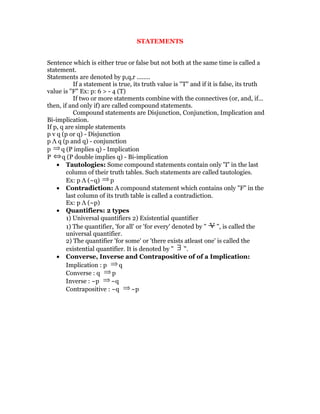Statements
- 1. STATEMENTS Sentence which is either true or false but not both at the same time is called a statement. Statements are denoted by p,q,r ........ If a statement is true, its truth value is ''T" and if it is false, its truth value is "F" Ex: p: 6 > - 4 (T) If two or more statements combine with the connectives (or, and, if... then, if and only if) are called compound statements. Compound statements are Disjunction, Conjunction, Implication and Bi-implication. If p, q are simple statements p v q (p or q) - Disjunction p Î q (p and q) - conjunction p q (P implies q) - Implication P q (P double implies q) - Bi-implication âĒ Tautologies: Some compound statements contain only 'T' in the last column of their truth tables. Such statements are called tautologies. Ex: p Î (~q) p âĒ Contradiction: A compound statement which contains only "F" in the last column of its truth table is called a contradiction. Ex: p Î (~p) âĒ Quantifiers: 2 types 1) Universal quantifiers 2) Existential quantifier 1) The quantifier, 'for all' or 'for every' denoted by " ", is called the universal quantifier. 2) The quantifier 'for some' or 'there exists atleast one' is called the existential quantifier. It is denoted by " ". âĒ Converse, Inverse and Contrapositive of of a Implication: Implication : p q Converse : q p Inverse : ~p ~q Contrapositive : ~q ~p

